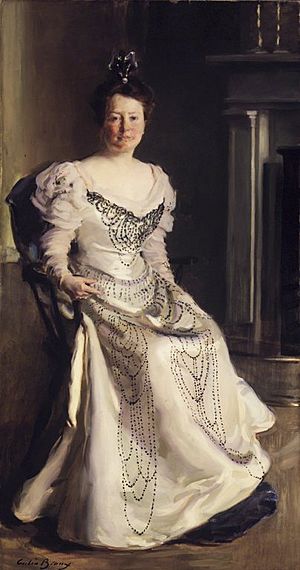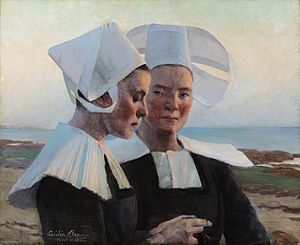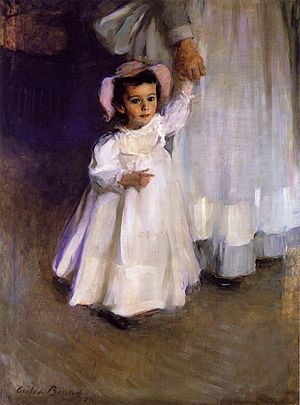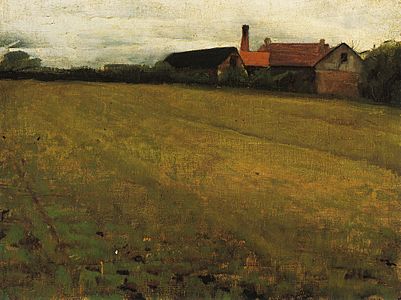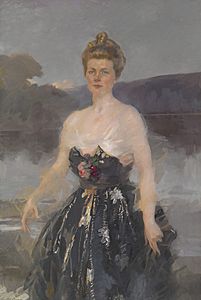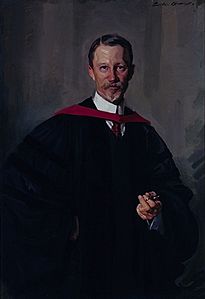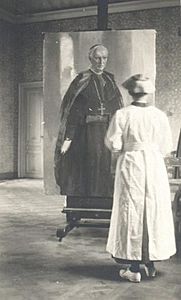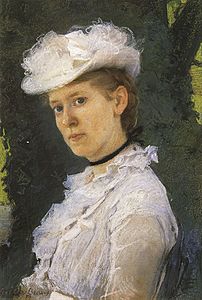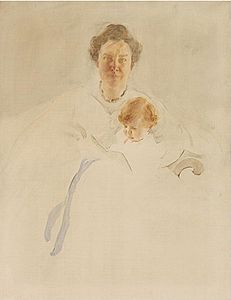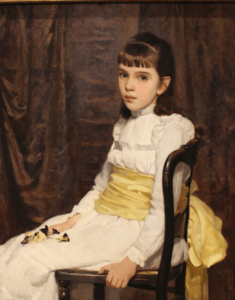Cecilia Beaux facts for kids
Quick facts for kids
Cecilia Beaux
|
|
|---|---|

Cecilia Beaux c. 1888
|
|
| Born |
Eliza Cecilia Beaux
May 1, 1855 |
| Died | September 17, 1942 (aged 87) |
| Nationality | American |
| Education | Francis Adolf Van der Wielen, Académie Julian, Académie Colarossi |
| Known for | Portrait painting |
| Movement | Impressionism |
| Awards | Mary Smith Prize, PAFA (1885, 1887, 1891, 1892) First Prize, Carnegie Institute (1899) Temple Gold Medal, PAFA (1900) Gold Medal, Exposition Universelle (1900) |
Eliza Cecilia Beaux (born May 1, 1855 – died September 17, 1942) was a famous American artist. She was the first woman to teach art at the Pennsylvania Academy of the Fine Arts. Beaux was known for her elegant and thoughtful portraits. She painted many important people, including First Lady Edith Roosevelt and Georges Clemenceau.
Cecilia Beaux trained in Philadelphia and then in Paris. There, she was influenced by artists like Tony Robert-Fleury and William-Adolphe Bouguereau. She also admired the work of Édouard Manet and Edgar Degas. People often compared her painting style to that of John Singer Sargent.
Beaux received a gold medal for her lifetime achievements from the National Institute of Arts and Letters. Eleanor Roosevelt even called her "the American woman who had made the greatest contribution to the culture of the world."
Contents
About Cecilia Beaux
Her Early Life
Eliza Cecilia Beaux was born on May 1, 1855, in Philadelphia. She was the younger daughter of Jean Adolphe Beaux, a French silk maker, and Cecilia Kent Leavitt, a teacher. Sadly, her mother died shortly after Cecilia was born.
Cecilia and her sister Etta were raised by their grandmother and aunts in Philadelphia. Their father returned to France for many years. He came back when Cecilia was two, but left again four years later. Cecilia later said, "We didn't love Papa very much, he was so foreign." However, her father was good at drawing and made fun sketches of animals.
Cecilia's aunt Emily married William Foster Biddle. Beaux later called him "the strongest and most helpful influence in my life." He supported his nieces with care and sometimes money. Her grandmother taught them to finish everything they started. The American Civil War was a tough time, but the family managed.
As a teenager, Beaux visited the Pennsylvania Academy of the Fine Arts. She was interested in the art but didn't plan to be an artist yet. She was a good student in French and Natural History.
At 16, Beaux began art lessons with her relative, Catherine Ann Drinker, who was an artist. Drinker became a role model for Beaux. She then studied with Francis Adolf Van der Wielen for two years. He taught her perspective and drawing. At that time, female students could not study anatomy directly or draw from live models.
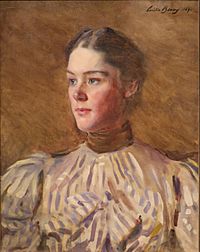
At 18, Beaux became a drawing teacher. She also gave private art lessons and made small portraits. She learned about lithography by copying for a printer. She also drew fossils for a scientific report. But she didn't enjoy this exact work.
In 1876, Beaux started attending the Pennsylvania Academy of the Fine Arts. She avoided the famous teacher Thomas Eakins, even though she admired his work. She studied portrait painting for three years. Beaux won the Mary Smith Prize at the Academy's exhibitions several times.
After leaving the Academy, Beaux tried porcelain painting. She found it too commercial. She then studied privately with William Sartain for two years. Sartain believed that physical looks were connected to personality traits, and Beaux adopted this idea.
Beaux then rented her own studio with other women artists. In 1884, she painted a large work called Les Derniers Jours d'Enfance (The Last Days of Childhood). It was a portrait of her sister and nephew. This painting won a prize and was shown in Paris. After this, she painted over 50 portraits in three years. She earned good money for her portraits.
Studying Art in Paris
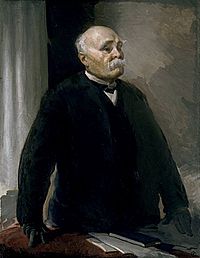
At 32, Beaux decided she needed more training. She moved to Paris with her cousin. She studied at the Académie Julian and the Académie Colarossi. She received weekly feedback from masters like Tony Robert-Fleury and William-Adolphe Bouguereau. She wanted these teachers to know her and see her talent. Her aunt often reminded her to focus on her art and avoid distractions.
When Beaux arrived in Paris, the Impressionists were becoming less popular. Their art was very different from the traditional art Beaux was learning. In the summer of 1888, Beaux tried painting outdoors like the Impressionists. But her style was too precise for Impressionism. She remained a realist painter throughout her career. She admired classic artists like Titian and Rembrandt. Her time in Europe did make her use lighter colors in her oil paintings, especially for women.
Becoming a Top Artist
Back in America in 1889, Beaux painted portraits of her family and important people in Philadelphia. She decided not to marry so she could focus on her art. Her family fully supported her choice. She worked hard, arriving at her studio on time and expecting the same from her models.
The next five years were very busy. She painted over forty portraits. In 1890, she showed her work at the Paris Exposition. She won gold medals in Philadelphia and New York. She also showed her art at the 1893 World's Columbian Exposition in Chicago. Her portrait Sita and Sarita, showing her cousin with a black cat, was very popular. Beaux gave this painting to a museum in Paris.
In 1895, Beaux became the first woman to have a regular teaching job at the Pennsylvania Academy of the Fine Arts. She taught portrait drawing and painting for 20 years. She was a very popular teacher. In 1896, she returned to France to see her paintings shown at the Salon. A French critic praised her work, saying no other female artist could compete with her.
Cecilia Beaux saw herself as a "New Woman." This term described women in the 1800s who sought education and careers. These women were often successful, well-trained, and chose not to marry. Beaux was a member of The Plastic Club in Philadelphia. This club helped women artists support each other and sell their art.
Moving to New York
By 1900, many people wanted Beaux to paint their portraits. She moved to New York City for the winters and spent summers at her home in Gloucester, Massachusetts. Her friend Richard Gilder, a magazine editor, helped her career. He introduced her to many important people. She painted Georges Clemenceau, First Lady Edith Roosevelt, and Admiral Sir David Beatty. She also sketched President Teddy Roosevelt.
Beaux became close friends with Gilder's daughter, Dorothea. Her portraits of children, like Fanny Travis Cochran and Ernesta and her Little Brother, show her great skill. She became a member of the National Academy of Design in 1902.
Later Life and Legacy
By 1906, Beaux lived year-round at her home in Gloucester. She found new people to paint and worked in the mornings. She believed that managing her energy was key to her success. She said that many women artists struggled because they couldn't handle the hard work every day.
While Beaux painted portraits of the wealthy, American art was changing. Artists like Robert Henri focused on everyday life. He told his students to paint common people. This was very different from Beaux's style. In 1907, Henri and his group, known as the Ashcan School, held their own exhibition. Beaux and her friends defended the older art styles. They thought the new movement was a passing trend, but it became a big change in American art.
In 1910, her beloved Uncle Willie died. Even at 55, Beaux continued to be very productive. In the next five years, she painted almost a quarter of all her works. She received many honors. In 1912, she had a big exhibition in Washington, D.C. However, the art world was moving towards Modernism. Beaux believed people would eventually prefer older art styles again.
In 1924, Beaux broke her hip in Paris, which affected her health. Her painting slowed down. That same year, she was asked to paint a self-portrait for the Uffizi Gallery in Florence. In 1930, she wrote her life story, Background with Figures. She received many honors in her later years. In 1933, Eleanor Roosevelt honored Beaux as "the American woman who had made the greatest contribution to the culture of the world." In 1942, she received a gold medal for her lifetime achievements.
Cecilia Beaux died at age 87 on September 17, 1942. She was buried in West Laurel Hill Cemetery in Pennsylvania.
Many people compared Beaux to Sargent, often saying good things about her. She had strong technique and understood her subjects well. Even though she is not as well-known today as Mary Cassatt, Beaux's skill and many paintings were highly respected in her time. In 1899, artist William Merritt Chase said, "Miss Beaux is not only the greatest living woman painter, but the best that has ever lived."
Beaux always aimed for perfection in her art. She said, "When I attempt anything, I have a passionate determination to overcome every obstacle."
Gallery
-
Painting of William Henry Howell (1919)
-
Cecilia Beaux painting of Cardinal Mercier (c. 1919)
-
Lady George Darwin, Beaux's pastel portrait of the former Martha du Puy of Philadelphia, who married Sir George Darwin. 1889
See also
 In Spanish: Cecilia Beaux para niños
In Spanish: Cecilia Beaux para niños


